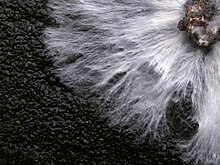Mycelium is the vegetative part of a fungus, consisting of a mass of branching, thread-like hyphae. The mass of hyphae is sometimes called shiro, especially within the fairy ring fungi. Fungal colonies composed of mycelium are found in soil and on or within many other substrates. A typical single spore germinates into a homokaryotic
mycelium, which cannot reproduce sexually; when two compatible
homokaryotic mycelia join and form a dikaryotic mycelium, that mycelium
may form fruiting bodies such as mushrooms. A mycelium may be minute, forming a colony that is too small to see, or it may be extensive:

Oyster mushroom (Pleurotus ostreatus) growing on coffee grounds
It is through the mycelium that a fungus absorbs nutrients from its environment. It does this in a two-stage process. First, the hyphae secrete enzymes onto or into the food source, which break down biological polymers into smaller units such as monomers. These monomers are then absorbed into the mycelium by facilitated diffusion and active transport.
Mycelium is vital in terrestrial and aquatic ecosystems for their role in the decomposition of plant material. They contribute to the organic fraction of soil, and their growth releases carbon dioxide back into the atmosphere. The mycelium of mycorrhizal fungi increases the efficiency of water and nutrient absorption of most plants and confers resistance to some plant pathogens. Mycelium is an important food source for many soil invertebrates.
Mycelium is a mass noun with no plural form.[1] The term mycelia does not exist in the Dictionary of the Fungi, but is often used incorrectly as the plural form of mycelium.
Sclerotia are compact or hard masses of mycelium.
Contents
Uses
One of the primary roles of fungi in an ecosystem is to decompose organic compounds. Petroleum products and pesticides, typical soil contaminants, are organic molecules, i.e. they are built on a carbon structure. This means that these substances present a potential carbon source for fungi. Hence, fungi have the potential to remove such pollutants from the soil environment, unless the chemicals prove toxic to the fungus. This biological degradation is a process known as bioremediation.Mycelial mats have been suggested (see Paul Stamets) as having potential as biological filters, removing chemicals and microorganisms from soil and water. The use of fungal mycelium to accomplish this has been termed mycofiltration.
Knowledge of the relationship between mycorrhizal fungi and plants suggests new ways to improve crop yields.
When spread on logging roads, mycelium can act as a binder, holding new soil in place and preventing washouts until woody plants can be established.
See also
References
- ^ Dictionary of the Fungi, 10th Edition. Wallingford, Oxfordshire, UK: CABI Publishing. 2008. p. 445. ISBN 1845939336.
- Stamets, Paul. Mycelium Running, Ten Speed Press,U.S.A. 2005 (p. 45, caption to figure 60)


























0 comments:
Post a Comment